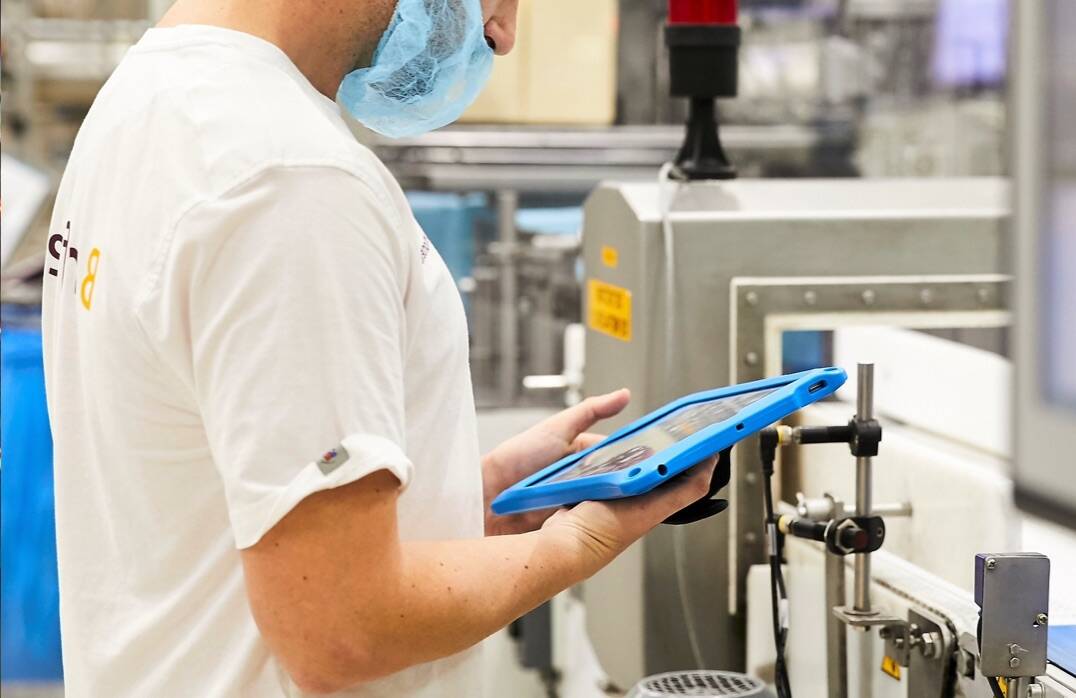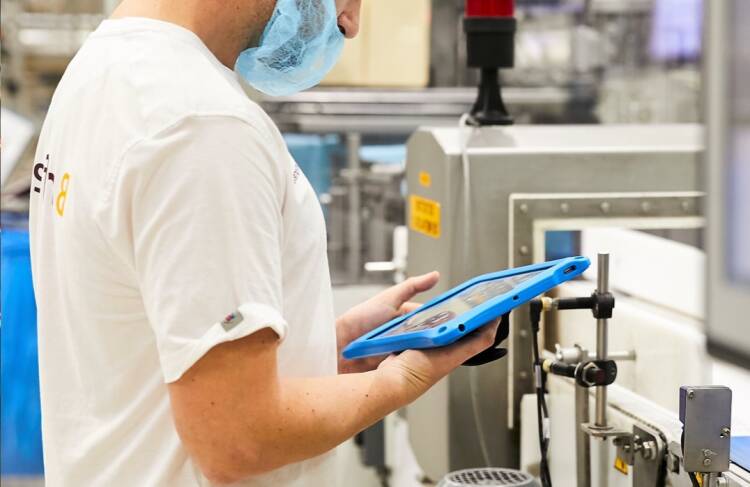
Part 6
To date, digitisation has mainly focused on connection: connecting information flows, centralising data and linking different departments together. Collecting data only appears to be relevant if it is subsequently used to improve the processes. And connection is crucial for this. Asked where digitisation is heading in the coming years, the participants state that even more connection will be at the forefront of developments.

The future lies in a smart supply chain, rather than smart links that operate separately from each other.”

Maar wat leveren die data nu concreet op? De tweede horde die maakbedrijven nemen, is die data op een overzichtelijke en efficiënte manier aan de medewerkers presenteren.
Guy De Winne (ST Engineering): “De voorbije jaren verzamelden we heel wat data, maar die zat verspreid over verschillende databases, zowel vanuit de productie en machines als uit de ondersteunende diensten. We wilden ervoor zorgen dat alle informatie gecentraliseerd werd in één datacube met verschillende views. Zodat elke medewerker vlot de juiste informatie voor zijn functie uit die centrale database kan halen.”
Voor Lavetan was de verhuis naar een nieuwe, ruimere locatie het startsein voor de digitale transformatie.
Jan Robrechts: “We tekenden één geautomatiseerde waardeketen uit, vanaf het vertrek van het staal bij de klant tot en met de factuur. In onze waardeketen triggert het einde van een procesfase automatisch de daaropvolgende. De intelligentie zit dus versleuteld in het systeem in plaats van in de hoofden van de medewerkers. Die waren immers steeds moeilijker te vinden.
“Onze groei stokte door de schaarste aan labotechnische profielen op de arbeidsmarkt. Maar versleutel je die knowhow zoveel mogelijk in je systemen en processen, dan breek je die talentvijver open. Vandaag heeft ongeveer de helft van onze medewerkers geen labotechnische achtergrond meer nodig.”
Maar het bleef niet bij procesautomatisering alleen. Zo’n vijf jaar geleden startte Lavetan met robotisering, vooral om 24/7 businesscontinuïteit te garanderen. Jan Robrechts: “En sinds een tweetal jaar zitten we in de zogeheten ‘intelligente transformatiefase’. Niet harder, maar vooral nog slimmer werken is nu het motto.”
We tekenden één geautomatiseerde waardeketen uit, vanaf het vertrek van het staal bij de klant tot en met de factuur.”

5. Processen automatiseren
Duracell also has plans in the pipeline to extend connectivity beyond the factory walls. Jan Casteels: “We are planning to expand our platform so that we can also exchange information with clients and suppliers. In this way, we would not only be connected within the factory but throughout the entire supply chain.
This starts with a relationship of trust.” “We are constantly looking for innovation partners who share our vision and are keen to participate in our process. Today, too many service providers take the view that their only role is to solve problems put forward by clients. We need partners who drive innovations themselves and show us what is possible.”
It isn’t the technology that forms the biggest barrier to a connected future, it’s the mentality."

The next step? A fully connected supply chain, in which both clients and suppliers exchange data in a single ecosystem and are connected in real time. A change is culture is required for this. Companies will only be able to enter into this kind of connected supply chain with complete transparency and mutual trust.
From connected factories to ecosystems
Pepijn Verhaeghe (Vandemoortele): “I hope that we will be able to collaborate with suppliers, B2B clients and other stakeholders in our ecosystem on a data-driven basis in about five years. After all, the future lies in a smart supply chain rather than smart links that operate separately from each other.”
Data-driven collaboration
Part 6 – Connectivity

From connected factories to ecosystems

Connected infrastructure
Guy De Winne (ST Engineering) confirms that this change in mentality is essential: “It isn’t the technology that forms the biggest barrier to a connected future, it’s the mentality,” says Guy De Winne. “When an error occurs today, people tend to be quick to point the finger. If we want to make the transition to a fully connected chain, we need to establish a culture of transparency.”
Change in mentality
A reliable and fast network is required not only to allow machines to communicate with each other, but also to allow data to be exchanged both internally and externally.
Francis Duvivier: “Proximus can play an important role here as a partner. Today, we are mainly doing this with a good internet and telephony connection and in some cases also with cloud infrastructure. We are currently looking ahead to 5G, a real game changer for industry. 5G offers a much faster connection and a faster response time, increased reliability and possibilities for connecting many more devices. The testimonies from the Factories of the Future also reveal this strong demand for connectivity.”
Geert Jacobs: “These faster response times and increased reliability levels will allow factories of the future to connect even more machines. For example, you can control robots, cobots and other machines wirelessly with a 5G network. Many companies are looking forward to an ecosystem with suppliers, clients and partners. A telecom operator such as Proximus can play a major part in this. With their experience in connectivity and data processing, it can be very useful for companies to look beyond the boundaries of their sector and learn from each other. We are seeing a clear shift of players like Proximus towards the manufacturing industry. In the future, such initiatives can provide leverage for setting up a true ecosystem.”
Connected infrastructure
Proximus can help you with your digital transformation.
Explore the range of solutions and services.
Would you like to become a Factory of the Future yourself?
Explore the range of solutions and services.
Want to digitise your own company?

Part 6
To date, digitisation has mainly focused on connection: connecting information flows, centralising data and linking different departments together. Collecting data only appears to be relevant if it is subsequently used to improve the processes. And connection is crucial for this. Asked where digitisation is heading in the coming years, the participants state that even more connection will be at the forefront of developments.
From connected factories to ecosystems
The next step? A fully connected supply chain, in which both clients and suppliers exchange data in a single ecosystem and are connected in real time. A change is culture is required for this. Companies will only be able to enter into this kind of connected supply chain with complete transparency and mutual trust.
Data-driven collaboration
Pepijn Verhaeghe (Vandemoortele): “I hope that we will be able to collaborate with suppliers, B2B clients and other stakeholders in our ecosystem on a data-driven basis in about five years. After all, the future lies in a smart supply chain rather than smart links that operate separately from each other.”

The future lies in a smart supply chain, rather than smart links that operate separately from each other.”

Duracell also has plans in the pipeline to extend connectivity beyond the factory walls. Jan Casteels: “We are planning to expand our platform so that we can also exchange information with clients and suppliers. In this way, we would not only be connected within the factory but throughout the entire supply chain.
This starts with a relationship of trust.” “We are constantly looking for innovation partners who share our vision and are keen to participate in our process. Today, too many service providers take the view that their only role is to solve problems put forward by clients. We need partners who drive innovations themselves and show us what is possible.”
Change in mentality
Guy De Winne (ST Engineering) confirms that this change in mentality is essential: “It isn’t the technology that forms the biggest barrier to a connected future, it’s the mentality,” says Guy De Winne. “When an error occurs today, people tend to be quick to point the finger. If we want to make the transition to a fully connected chain, we need to establish a culture of transparency.”
It isn’t the technology that forms the biggest barrier to a connected future, it’s the mentality."

Connected infrastructure
A reliable and fast network is required not only to allow machines to communicate with each other, but also to allow data to be exchanged both internally and externally.
Francis Duvivier: “Proximus can play an important role here as a partner. Today, we are mainly doing this with a good internet and telephony connection and in some cases also with cloud infrastructure. We are currently looking ahead to 5G, a real game changer for industry. 5G offers a much faster connection and a faster response time, increased reliability and possibilities for connecting many more devices. The testimonies from the Factories of the Future also reveal this strong demand for connectivity.”
Geert Jacobs: “These faster response times and increased reliability levels will allow factories of the future to connect even more machines. For example, you can control robots, cobots and other machines wirelessly with a 5G network. Many companies are looking forward to an ecosystem with suppliers, clients and partners. A telecom operator such as Proximus can play a major part in this. With their experience in connectivity and data processing, it can be very useful for companies to look beyond the boundaries of their sector and learn from each other. We are seeing a clear shift of players like Proximus towards the manufacturing industry. In the future, such initiatives can provide leverage for setting up a true ecosystem.”
Want to digitise your own company?
Proximus can help you with your digital transformation.
Explore the range of solutions and services.
Would you like to become a Factory of the Future yourself?
Explore the range of solutions and services.